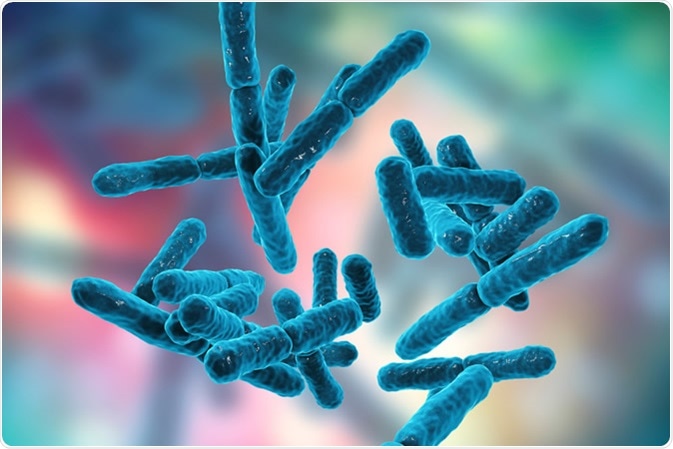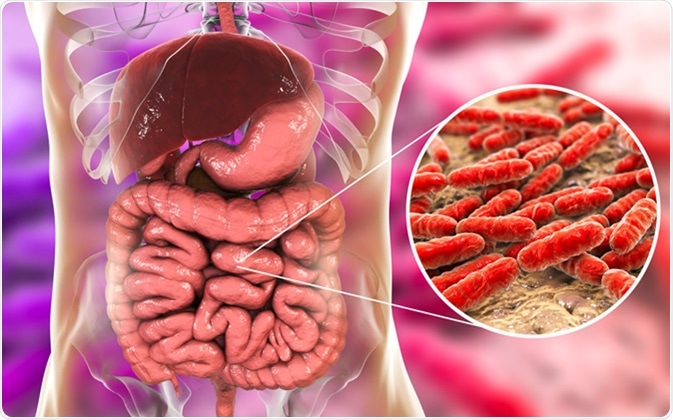Skip to:
What are probiotics?
Probiotics are living microorganisms, taken as oral supplements or topically, that are used for their purported health benefits. Some commonly used probiotic products include yogurts and other fermented foods, or pills containing selected microbes.
The basis of probiotic use is the natural role played by human gut bacteria in promoting human health. Some of their benefits include the production of fermentation products like short-chain fatty acids, vitamin K, helping to digest food remnants, controlling the growth of harmful microbes, or pathogens, and maintaining mucosal integrity.

Bacteria Bifidobacterium, gram-positive anaerobic rod-shaped bacteria which are part of normal flora of human intestine are used as probiotics and in yoghurt production. 3D illustration Credit: Kateryna Kon / Shutterstock
Probiotics have been used for a number of health conditions, such as
- Digestive disorders like infectious diarrhea, antibiotic-associated diarrhea, and functional bowel disorders
- Allergic conditions like atopic dermatitis and hay fever
- Dental and periodontal disease
The evidence supporting their use is limited, however, to functional disturbances of the gut. We still don’t know much about which type of microbes to use, the best dosage, or the target population. In fact, the FDA has not approved any probiotics for any health so far because of the absence of any experimental proof of their benefits. Probiotics are thus completely unregulated.
Does this mean probiotics are harmless?
The benefit or danger of probiotics depends largely on the state of health and the existing treatment of the person taking them. In healthy people, they are generally thought to be safe, but some adverse effects like bloating, flatulence and diarrhea have been reported with bowel inflammation, as in functional gut disorders.
Even in this group, long-term safety has never been studied. Most research has focused on just two types of bacteria, namely, Bifidobacterium and Lactobacillus. Many others are typically part of the mix, even though we don’t know if they would be useful or dangerous.
For instance, just because one strain of a particular bacterium like Lactobacillus is found in the human gut at a particular age, it cannot be taken to mean that all lactobacilli strains are beneficial at all ages, without further evidence. Still less would it mean that any type of beneficial bacteria could be used to supplement the gut flora in any given population. There simply isn’t evidence to decide on the safety of probiotics.

Normal flora of small intestine, bacteria Lactobacillus. 3D illustration Credit: Kateryna Kon / Shutterstock
It is interesting that the relative proportions of different microbes in the human gut are completely different from that seen in many animal models used to study probiotic safety. For instance, Lactobacillus makes up 63% of normal gut flora in the mouse, but only 0.05% in the human gut. Prevotella and Fecalibacterium make up 51% and 49% of the bacteria in the human gut, but only 0.9% and 0.3% respectively in the mouse.
And more recent results from techniques such as metagenomics yield contradicting results compared with culture results. For instance, Lactobacillus and Bifidobacterium were thought to be lower in patients with inflammatory bowel disease, than in healthy controls, but mucosal brush samples show the reverse to be true.
Probiotics can kill
When it comes to people with serious medical illnesses, those who are very weak, or have overwhelming infections, probiotics may harm. Their use has been reported in numerous case reports to lead to sepsis in such situations, including in critically sick patients, post-operative patients, infants with serious illness, the elderly and immunocompromised patients.
Many patients in an intensive care setting have developed bacteremia or fungemia after being administered probiotics. The risk is higher if they have indwelling central venous catheters. The infection can cause sepsis in other patients in the same ward or room, perhaps through air, fomites, or hand contact.
For instance, treatment with a probiotic containing Saccharomyces cerevisiae (baker’s yeast) resulted in fungemia in both those who took it and in others who did not. About 60 such cases are known, with almost two-thirds being in the intensive care unit. Freeze-dried preparations of this fungus are used in several countries to prevent antibiotic-induced diarrhea in ICU patients, and for inflammatory bowel disorders. The powder could become airborne and contaminate the central venous catheter, leading to systemic infection.
Bifidobacterium also causes invasive infection and even sepsis in patients with low immune function, while both Bifidobacterium and Lactobacillus are linked to dysbiosis in patients with inflammatory bowel disease. Care must be exercised in these patients, especially when they are on immunosuppressive medications.
Other observed adverse effects of probiotics have included skin complications, endocarditis, gene transfer from the probiotics to the patient’s normal gut microflora, metabolic disturbances, and overactive immune function.
In cancer patients on immunotherapy with anti-PD-1 checkpoint inhibitors, probiotic intake should be avoided as they can reduce chances of remission.
Probiotic safety in infants, especially preterm babies, is also not established because their immune systems are still developing.
Sources
- Nccih.nih.gov. (2016). Probiotics: in depth. https://nccih.nih.gov/health/probiotics/introduction.htm
- Naspghan.org. (2006).Clinical efficacy of probiotics: review of the evidence with focus on children. Journal of Pediatric Gastroenterology and Nutrition.
- Perapoch J. et al., (2000). Fungemia with Saccharomyces cerevisiae in two newborns, only one of whom had been treated with ultra-levura. European Journal of Clinical Microbiology and Infectious Diseases. https://www.ncbi.nlm.nih.gov/pubmed/10947224
- Munoz P. et al., (2005). Saccharomyces cerevisiae fungemia: an emerging infectious disease. Clinical Infectious Diseases. doi: 10.1086/429916
- Khalighi A. et al., (2016). Probiotics: A Comprehensive Review of Their Classification, Mode of Action and Role in Human Nutrition. Probiotics and Prebiotics in Human Nutrition and Health (Rao V. and Rao L. G.). IntechOpen, DOI: 10.5772/63646.
- Cassone M. et al., (2003).Outbreak of Saccharomyces cerevisiae subtype boulardii fungemia in patients neighboring those treated with a probiotic preparation of the organism. Journal of Clinical Microbiology. doi: 10.1128/JCM.41.11.5340-5343.2003
- Enache-Angoulvant A. et al., (2005). Invasive Saccharomyces Infection: A Comprehensive Review. Clinical Infectious Diseases. https://doi.org/10.1086/497832
- Uno Y. (2019). Risk of probiotics: functional gastrointestinal symptoms in patients with inflammatory bowel disease. Clinical Gastroenterology and Hepatology. https://doi.org/10.1016/j.cgh.2019.04.031
- Ascopost.com. (2019). AACR 2019: Diet may influence gut microbiome and response to immunotherapy. https://www.ascopost.com/News/59786
Further Reading